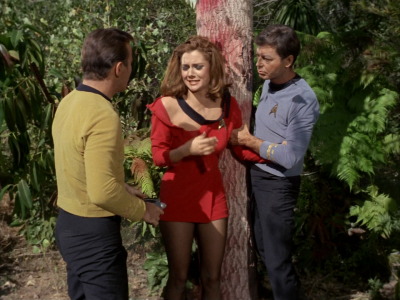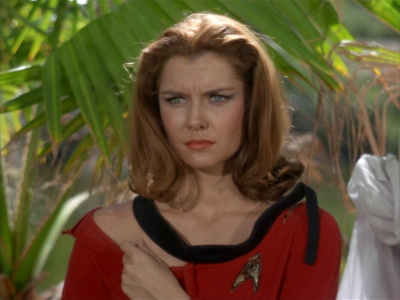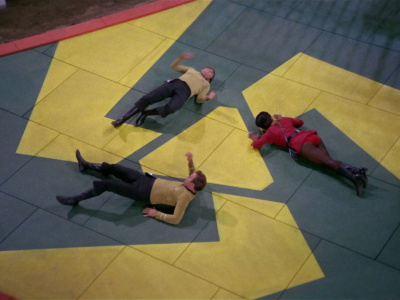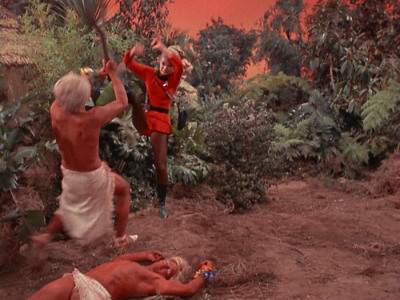
Every Trekker with an eye for costuming knows that the shirts worn by Starfleet officers on STAR TREK: The Original Series are officially called tunics, giving them a special flair and distinctiveness as befits this component of a military-style uniform. The only problem with this narrative is that none of it appears to be true or accurate.
In 2020, Starfleet.ca decided to stop "going with the flow" where this common term amongst the fan-base was concerned, revising its articles to eliminate numerous references to men's "tunics" in favour of "shirts". ("Wraparound tunics" simply became "wraparounds", as a qualifier is wholly unnecessary.)
Often-times, there is an interesting backstory when words fall into common mis-use. This article will examine why men's uniform tops are correctly shirts, and how the "tunic" movement may have arisen.
It will also bring to light that many bona fide tunics did appear in TOS — but by canon definition, they are not at all what many believe them to be!
Men's Shirts
The so-called "tunic" tops worn by male officers on TOS are obviously shirts by dictionary definition, but which is the official/correct term?
Why "Tunics" Are Shirts
Put simply, every authoritative source that the author has encountered refers to this uniform component exclusively as a "shirt".
On-screen dialogue – being the canon source – rarely got more specific than mentioning "uniforms", but shirts were confirmed on two occasions.
The first was by Ensign Chekov in “The Deadly Years” [2x11]:
CHEKOV: Give us some more blood, Chekov. The needle won't hurt, Chekov. Take off your shirt, Chekov. Roll over, Chekov. Breathe deeply, Chekov…
The second was by Captain Kirk in “Spectre of the Gun” [3x01]:
KIRK: I know this is hard to understand, but I'm Captain James T. Kirk of the spaceship Enterprise. These men are part of my crew. We're not really here, we're from the future. We haven't been born yet. Feel the material in my shirt. Now feel the material in your own shirt. Do you notice any difference?
We then go behind the scenes to costume designer William Ware Theiss, who was known to be a private man that almost never gave an interview — but did on two key occasions.
In the second part of his 1968 Interview with D.C. Fontana for "INSIDE STAR TREK", he said of the uniforms:
We tried to find three colors for the shirts that would be as different from each other as possible in black and white as well as color. Anyone who has read The Making of Star Trek knows the sad stories connected with the velour from which the shirts were made, and it wasn't until the third year that we were able to find a satisfactory -- in fact, a superb -- replacement. The new fabric is a stretch nylon doubleknit. It doesn't shrink as the velour does, and it molds to the body, giving a much smoother fit. And to my amazement and the actors' delight, it's cooler than the velour, though it is no lighter in weight.
In the "Lost Interview" – a 1992 article entitled "A STITCH IN TIME" that draws upon James Magda's 1988 conversation with the designer – he was quoted as stating It was one of those film stock things; it photographed one way — burnt orange or a gold. But in reality was another; the command shirts were definitely green
.
(N.B.- To avoid fostering misinformation in the "gold vs green" controversy, be it noted that Mr Theiss' retrospective comments on colour should be taken only in regards to the 3rd season nylon double-knit: for which the Command fabric was indeed avocado green in daylight, but photographed yellow.)

Moving into "THE MAKING OF STAR TREK" (September, 1968) (mentioned above by Mr Theiss), we have a thoroughly unique reference. It is the only behind-the-scenes book to have been written while the show was being made, as co-authored by Stephen E. Whitfield in direct consultation with creator Gene Roddenberry.
There as well, the word "shirt" is used exclusively: such as the in-universe statement that the crew operates at all times in a shirt-sleeve, controlled-gravity environment
on page 210, or that a design change was also contemplated for the men's shirts, as well as modifications to their trousers
when speaking of Bill Theiss redesigning the costumes on page 262.
The following anecdote about a Spock uniform also appears on page 311:
The wardrobe man (key costumer) comes in and asks Leonard if he's had his new shirt fitted yet. Leonard says no. The wardrobe man says he will leave the shirt in Leonard’s dressing room and departs.
Speaking of Gene Roddenberry, "THE STAR TREK GUIDE" for writers and directors (3rd rev., 1967) in its page 19 entry on THE PHASERS
states that the hand phaser (along with the communicator) is worn on a belt hidden under the shirt
. (Of course, this particular usage of weapons belts was later supplanted with loop tape sewn directly to the trousers.)
Furthermore, the vintage pattern that was released by Lincoln Enterprises (a.k.a. The Roddenberry Shop) under Majel Barrett and affirmed as being the real design as created by William W. Theiss and worn by the Enterprise crew
was marketed as the Classic Men's Uniform Shirt. (See: TOS Men's Shirt - Pattern Selection)
Finally, on a lighter note, it bears consideration that nobody has ever told a cliché joke about a "redtunic".
Why Shirts Are Not Tunics
In contrast to the previous section, the author has yet to uncover any authoritative production source that described the uniform shirts as "tunics".
Since Starfleet terms are based in United States naval tradition, the U.S. Navy Uniform Regulations were also examined. Nothing in the author's collection of 8 versions (dating back to 1941) revealed any basis for "tunic". That wasn't surprising, as it is chiefly a British term (and doesn't refer to a shirt regardless).
Finally, dictionaries covering both British and U.S. English (namely Oxford, Merriam-Webster, and the more generalised Dictionary.com) were consulted to see if TOS shirts fit any reasonable definition of "tunic" — and the answer here is also negative.
Clothing definitions of "tunic" fall into three categories:
- HISTORICAL
- A loose garment, typically sleeveless and reaching to the knees, as worn in ancient Greece and Rome.
- A simple slip-on garment made with or without sleeves and usually knee-length or longer, belted at the waist, and worn as an under or outer garment by men and women of ancient Greece and Rome.
- A gownlike outer garment, with or without sleeves and sometimes belted, worn by the ancient Greeks and Romans.
- CHIEFLY BRITISH
- A close-fitting short coat as part of a uniform, especially a police or military uniform.
- A long usually plain close-fitting jacket with high collar worn especially as part of a uniform.
- A coat worn as part of a military or other uniform.
- LADIES' FASHION
The Historical category is obviously out.
The Chiefly British category is what the shirts are being shoehorned into, but they simply do not meet the key criteria of being a coat or jacket.
The Ladies' Fashion category is also obviously out — but we shall return to it shortly, for a different reason!
From Whence "Tunic" Came
One should question how and why "tunic" came about, if it didn't originate from the production.
The usual assumption is that it was to "sound more militaristic", but another possibility exists. In vintage fashion, what most would now call a dress shirt went by several names, one of which was tunic shirt. These were indeed tunic-length at the time; a back length upwards of 3 ft (almost 0.9m) was typical. Thus, the advent of "tunic" may have been a misuse of a fashion term rather than a military one.
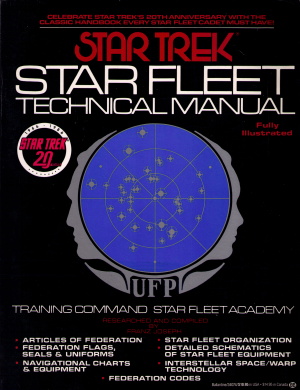
As for when it arose, the exact answer is uncertain, but a key text is the non-canon "STAR FLEET TECHNICAL MANUAL" (1975) by Franz Joseph.
This amazing in-universe compilation has been on the bookshelves of countless die-hard Trekkers for decades: many of which spent significant hours pouring over its documents and diagrams in the pre-Internet age.
With no disrespect to its author for the heroic undertaking of designing such a volume, the Technical Manual managed to be as stunningly correct on certain finer points of design as it was woefully inaccurate on others.
In technical orders TO:01:03, the woman's uniform top is very correctly labelled a tunic
(and this is what the entire next section is devoted to!) — but at the same time, so is the men's.
Was Franz Joseph the first to call the men's shirt a tunic, and was it an attempt to create unisex terms for Starfleet uniform components? Unknown! However, its usage in the SFTM undoubtedly had a major impact in proliferating the term to future generations.
N.B.- As this section remains highly speculative, anyone with a published reference to a TOS "tunic" predating 1975 is strongly encouraged to contact Starfleet.ca with that information!
Women's Tunics
Going back to on-screen dialogue as our canon source, one "tunic" was directly named on TOS.
The words I was thinking, even before my tunic was torn...
were spoken by Yeoman Tonia Barrows in reference to her damaged "uniform dress" in “Shore Leave” [1x17]:
In quite an interesting twist, it is actually the women's standard uniform tops that are tunics!
Does this one line of dialogue hold up against correct terminology in ladies' fashion? The answer is yes: thoroughly so.
Dictionary definitions of "tunic" in this category include:
- A loose, thigh-length garment, worn typically by women over a skirt or trousers.
- A hip-length or longer blouse or jacket.
- A short overskirt.
- A woman's upper garment, either loose or close-fitting and extending over the skirt to the hips or below.
- A garment with a short skirt, worn by women for sports.
As if we need continue, Simplicity's "Simply The Best Sewing Book" (a long-standing publication that the author highly recommends to anyone beginning to learn to sew) just happens to have a DRESS, TUNIC OR TOP
as its example pattern, showing implications of these terms in its first diagram:

The Problem With "Dresses"
It can be argued that describing the female officer's tunic as a "dress" (or "mini-dress") is not inaccurate.
However, "tunic" being more specific helps to alleviate several issues: one of which is the confusion that may arise between "uniform dresses" and Dress Uniforms!
Besides that, the word "dress" encompasses quite a broad range of garment styles (including tunic dresses), but tends to imply an "all-in-one" piece of clothing that:
- provides modesty, and
- is therefore necessarily of a modest length.
Thus, using it in relation to TOS uniforms has been observed to repeatedly create two main points of avoidable confusion with those who are new to Trek costuming.
In related forums, one regularly sees comments that
- exclaim surprise at "how short those dresses are", and
- segue into the erroneous belief that said "dresses" are designed entirely for style and do not make practical uniforms.
On the other hand, "tunic" inherently conveys the intended mid-thigh length, and implies that uniform bottoms are also required — above and beyond the visible hosiery.
Every tunic on TOS was worn with a matching pair of shorts. These were clearly seen in various action shots, such as the following examples of Dr Helen Noel in “Dagger of the Mind” [1x10] and Lieutenant Uhura in “The Gamesters of Triskelion” [2x17]:
The bottoms weren't custom-created; rather, "cheer shorts" (or "cheer briefs"), commonly found in dance-wear shops, were acquired in colours most closely matching the uniforms.
Unfortunately, retail TOS uniform dresses (and patterns for the same) don't always communicate this pertinent piece of information to the customer, leaving many unaware of a critical component.
With these in place comes the understanding that the tunic was never intended to provide modesty: but rather, was designed with a short skirt and wide vents to allow a full and unrestricted range of motion.
Common examples of this can be observed — as well as dramatic ones, such as Yeoman Martha Landon easily dispatching multiple attackers in “The Apple” [2x09]:
Development & Reception
Of further interest is an interview conducted with Grace Lee Whitney, whose role as Yeoman Janice Rand was initially conceived of as being a central character on TOS (appearing in 8 episodes before changes in writing direction saw the captain's yeoman become a series of guest actresses).
Prior to the start of filming, publicity photos with prototype uniforms had her wearing a shirt & slacks from the pilot episodes, rather than the red tunic and unique wig that would be her on-screen hallmark:
As recounted on page 87 of "THE STAR TREK INTERVIEW BOOK", by Allan Asherman (1988):

AA In those photos, you were wearing the same costume worn by Andrea Dromm in "Where No Man Has Gone Before."
GW I was in pants. I rebelled, because to me it should have been a big belt with a short skirt, boots, and long legs. That's what I saw. And when I said that to Bill Theiss, he had the same image. Bill designed the shorts with the skirt lap over the top: the famous uniform.
AA Whose idea were the pants?
GW I don't know. They were in the pilots, before I got there. When we put legs into the format I think that helped sell the series.
AA What do you think of the costume you wore in the series?
GW I thought it was sensational. It stopped traffic, and being an egocentric actress, the more attention I could get, the better.
The fact that she describes the new uniform primarily as shorts with the skirt lap over the top
shows an astuteness in not only being amongst those who initially suggested the change, but having no misconceptions about the form and functionality of the final tunic design.
Nichelle Nichols (Lieutenant Uhura) – who similarly "rebelled against pants" and requested a skirt option for her Monster Maroon when Star Trek went to the silver screen – also made some definite comments about the coverage & mobility provided by her TOS uniform, when a BBC interviewer suggested it was very revealing
:
So? I was wearing them on the street. What's wrong with wearing them on the air? I wore 'em on airplanes. It was the era of the miniskirt. Everybody wore miniskirts. … They revealed nothing. I had long black stockings on, and boots up to my knees, and the skirts and panties on, and a skirt that gave you freedom to move in. So what? It amazes me because everything is more revealing today on the street than those costumes.
(On a separate note of interest, the correct naval terms for "pants" are trousers for men and slacks for women.)
Dress Uniforms & Uniform Dresses
Acknowledged here for completeness, there was one uniform dress on TOS that is best described as such.
Perhaps fittingly (or ironically), it is the women's Dress Uniform dress, as worn at trial by Lieutenant Areel Shaw in “Court Martial” [1x14]:
Made out of the same satin material as the men's Dress Uniform jackets, this is a dress in the bona fide sense of the word: featuring a lengthier cut that goes most of the way down to the knees.
Its subtle differences reflect the level of conscientiousness that underscored all TOS uniform design, as it is clearly a separate type of garment intended for formal occasions.
On Military Fashion (Past & Present)
Returning to the men: while some may be resistant to relinquishing the word "tunic" and its aforementioned flair, a more interesting story about STAR TREK and the history of military fashion comes to light once we recognise that shirts were being portrayed as the standard uniform of a Starfleet officer.
"THE STAR TREK GUIDE" for writers and directors (3rd rev., 1967) states on page 24:
CLOTHING AND RELATED GEAR
Except in exceptional circumstances necessary to a story, our crew is always dressed in "standard uniform" or "dress uniform." Unless an important story point, let us provide "fatigues" and leisure wear as our budget permits.
We'll put aside for the moment that Gene was drawing on his Army service when he wrote fatigues
for what are, in naval terminology, Working Uniforms (namely the coveralls that we see Enterprise crewmen of both genders wearing when "standard uniforms" are impractical for labour).
Noting the quotation marks, in the context of the Guide, these can be taken as descriptive rather than official Starfleet terms. Certainly the Navy did have official designations of Dress Uniforms, but "standard uniform" is of chief interest here.
It manifested in just one line of dialogue, when Captain Kirk ordered changing out of Dress Uniforms into standard dress
for the landing party in “The Savage Curtain” [3x22].
The fact is, there was no good military precedent for what to call a "standard uniform", since the U.S. Navy had no analogous designation — at the time!
In the 1960s (just as today) Navy officers had Service Dress Uniforms that featured a coat.
Unlike today, the regulation was that these are the basic uniforms for United States naval officers
(1959, 1964):
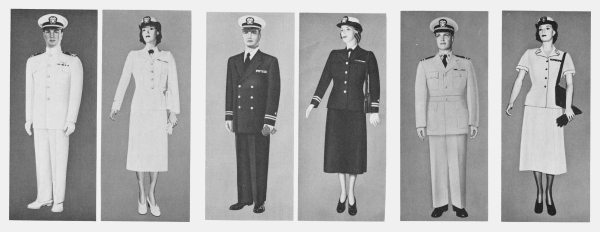
Shirt sleeves (regardless of whether with trousers or dungarees) were relegated to the category of Working Uniforms: worn when Service Dress would be unwieldy, unsafe, or likely to become soiled.
Military fashion has often taken its cues from what was considered appropriate business dress for a gentleman in civilian life — and in the 1960s, it was not considered professional for an officer to appear without a jacket, unless there was a practical "working reason" for doing so.
In the years that followed, loosening of fashion restrictions saw a shirt & trousers gain widespread acceptance as appropriate "business casual" attire in society. Following suit, the U.S. Navy eventually created another designation in between Service Dress Uniforms and Working Uniforms.
New "Service Uniforms" became the 20th-century version of what Gene & company envisioned an officer of the future would regularly wear: shirt & trousers for men, and shirt & skirt (or optional slacks) for women — noting from several brief appearances that a shirt & slacks option also existed for female crewmen onboard the Enterprise, although very few chose to wear it.
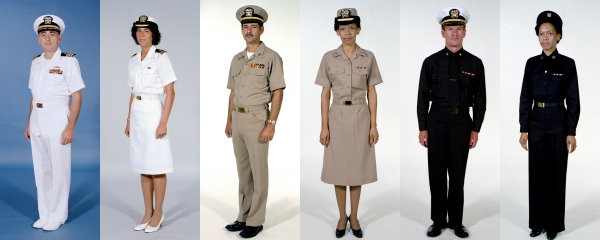
Naval Service Uniforms are approved for office work, watchstanding, liberty, or business ashore when prescribed as uniform of the day
, while Service Dress Uniforms are now worn for official functions where full/formal dress is not required, but civilian equivalent dress is coat and tie
.
Coming full circle, Starfleet's "standard uniform" should rightfully be named a Service Uniform — and probably would have been, had such a thing yet existed!
Our takeaway is to recognise the evolution of the shirt in both business and military fashion, and how STAR TREK was in this regard (as in so many others) once again ahead of its time.
Into The Future
Clearly, this article forwards a justifiable argument that men's "tunics" are best called shirts, and women's "dresses" are best called tunics in dealing with Starfleet uniforms of the late 2260s.
Of course, decades of calling the men's uniform top by the term that would actually have been best applied to the women's throws two rather large wrenches into the works of correctness — although words can evolve to encompass additional meanings over time.
While none can know exactly what a "tunic" will be recognised as in the 23rd century, it has certainly developed such synonymity with a "shirt" in the modern-day Trek community that it would not be a good use of time to try actively correcting it.
However – as Starfleet.ca strives to accurately present what was true at the time the episodes were being made rather than what subsequently "became true" – this website now endeavours to use the terms shirt and tunic according to their original (canon dialogue) intentions, while still acknowledging that these uniform components are commonly called "tunics" and "dresses", respectively, at present.
Acknowledgements
- Star Trek: TOS screencaps from TrekCore.
- Dialogue quotations from Chrissie's Transcripts Site.
- Photos of screen-used originals and other material at Star Trek Prop, Costume & Auction Authority.

